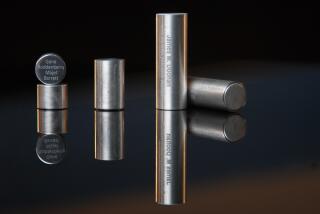Out of This World : Pictures from NASA’s interplanetary missions have both scientific and visual impact.
However blase we have become about space shuttle flights and spacecraft that travel to distant planets, the photographs from these missions are nothing short of awe-inspiring.
The National Aeronautics and Space Administration’s interplanetary vehicles have taken thousands of striking pictures of Mars, Jupiter, Saturn, Uranus, Neptune and various celestial bodies, giving earthlings their closest encounters with them. A sampling of color images from various missions is on view at the Pierce College Art Gallery in the exhibit “A Journey to the Planets.”
Six of the pictures are photographic prints, and 30 more images have been nicely realized as color Xeroxes. Made from transparencies, these photocopies reflect not only the mysterious beauty of the planets but the ever-improving quality of this form of color reproduction.
“This show has a lot of visual impact. I thought an exhibit as exciting as this both scientifically and visually would be inspiring for the students,” said Joan Kahn, the gallery director.
Two charts, one detailing our solar system and the other presenting an overview of the universe beyond, provide a context for the images and a reminder of just how far technology has come to satisfy people’s curiosity about the unknown.
“From the beginning, mankind has moved and searched, ever looking beyond the horizon,” said Jurrie Van der Woude, senior representative in the public information office of Jet Propulsion Laboratory in Pasadena, who provided Kahn with the transparencies from the missions.
“Communities eventually became seafaring nations, crossing oceans to explore and settle. But it was only in the late 20th Century that mankind stepped from the home planet and became space-farers, exploring other worlds.”
The exhibit begins with images from the Viking missions to Mars. Vikings 1 and 2, NASA’s first attempts to land spacecraft on another planet, were sent to study Mars from orbit and to put two landers on the planet to scrutinize its surface.
Viking 1’s lander touched down on Mars in July, 1976; Viking 2’s lander followed that September.
“This is another planet,” Kahn said, pointing to the photograph of Mars’ surface. “It’s mind-boggling. It’s an exciting photo because you see our presence--the vehicle--and the soil and texture of the planet.”
Two Voyager spacecraft were launched from the Kennedy Space Center in Florida in 1977. Voyager 1 flew by Jupiter in March, 1979, and Saturn in November, 1980. Voyager 2 passed both planets before it continued on to encounter Uranus, the seventh planet from the sun, in January, 1986, and Neptune in August, 1989.
A photograph of the Voyager spacecraft accompanies images of Jupiter’s red spot and moons. “Montage of Saturnian System” hangs next to vibrant photocopies showing Saturn’s rings and moons. Voyager 2’s closest approach to Uranus was 50,600 miles above the planet’s clouds. The spacecraft returned extensive data on the planet’s rings and moons.
How many of us knew that Neptune has rings? Voyager 2 captured details of Neptune’s ring system before it continued on its journey beyond our solar system.
Finally, there is a series of images generated from the Infrared Astronomical Satellite II (IRAS). Launched in January, 1983, it spent the next 10 months taking pictures of celestial objects. Among other celestial bodies on display here are the Andromeda and Milky Way galaxies.
WHERE AND WHEN
What: “A Journey to the Planets.”
Location: Pierce College, 6201 Winnetka Ave., Woodland Hills.
Hours: 11 a.m. to 3 p.m. Monday to Friday and 6 to 9 p.m. Tuesday, through Sept. 15.
Call: (818) 719-6498.






